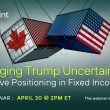2018 Investment Outlook: In a tepid U.S. economy, where do we see growth opportunities?
As the Invesco U.S. Growth Equities team looks into 2018 and observe the weight of the evidence, we think the U.S. equity markets can achieve mid- to high-single-digit price appreciation in 2018 as we continue in the secular bull market that began in March 2009.
We base this view on continued tepid economic growth in the U.S., we expect real gross domestic product (GDP) to be 2%, driving mid-single-digit earnings growth plus 2% dividend yield. Our conclusion assumes flat margins, slightly lower share count and a flat price-to-earnings (P/E) multiple.
The U.S. economy: A long, but mild, recovery
2009-2017 has been the third-longest economic recovery in U.S. history, but the rate of growth has been 30% lower than the average of the previous 60 years.1 In light of this subdued growth, few excesses have had the opportunity to develop. Therefore, we think slow economic growth could continue over the next two years.
When defining GDP growth in the context of output potential (labour force growth plus productivity gains), 2% real GDP growth would be very consistent with expectations. Demographics will continue to play an influential role in our economic growth rate. Aging baby boomers retiring from the work force are contributing to slower labour force growth year over year. These boomers have higher average wages and higher productivity levels than newer, younger workers. As a result, productivity levels are 30% below historical average trends.2 Neither of these trends is likely to improve significantly until the growth rate of Americans aged 20 to 64 bottoms, which is expected to happen between 2022 and 2024.3
The economic cycle: Timing matters
Over the last 60 years, equity market cycle returns for the S&P 500 Index have been two- to three-times higher when the economy is in the early acceleration stage versus the mid cycle.4 Mid- to late-cycle returns have averaged between 6% and 9%, in line with what we expect over the next couple of years.4 The biggest risk to this view is a change in leadership at the Federal Reserve that would result in monetary policy tightening too quickly. Higher interest expense would drive corporate earnings growth lower and could drive the economy into a recession by crowding out business’ ability to fund growth through attractive borrowing rates.
In our view, tepid economic growth during this mid-late stage of the cycle creates an ideal set-up for investment in long-term, secular growth themes based on innovation driving market share gains. (Opportunities for cyclical growth are more limited without a reacceleration of leading economic indicators in the U.S.)
Technology is driving secular growth opportunities
Technology is changing how we do everything. Worldwide access to the smartphone is bringing the consumer closer to the internet anywhere and anytime – global internet penetration is now at 50% and rising rapidly.5 These changes are driving seismic shifts in market share between companies, creating winners and losers, and fostering an excellent environment for bottom-up fundamental research and stock picking.
Here are several examples areas where our U.S. Growth Equities team is finding secular growth opportunities:
- E-Commerce: Only about 10% of U.S. commerce currently happens online,6 but we believe this will grow to 30% or more of total retail. Food and food service, autos and auto parts, furniture, appliances, and luxury goods have yet to see significant online penetration.
- Video game content providers: U.S. consumers spend 11% of their mobile device time playing video games, compared to 19% reading and posting on Facebook, and 14% watching other entertainment like movies and TV shows.7 The improved graphic processing power of the smartphone and the proliferation of downloadable content is expanding the number of potential gaming devices from more than 400 million (video game consoles and personal computers) to 3.5 billion (smartphones).8
- Health care tech: Big data, super-computing power, robotics, miniaturization and genome mapping are driving innovation in pharmaceuticals, biotechnology and health care devices. For instance, increases in computing power and the application of artificial and machine learning has brought the cost to sequence a single genome down from $100 million in 2001 to less than a $1,000 now, and has driven a 19-fold increase in genomic knowledge over that time period.9 Clinical drug trials that use selection biomarkers for enrolling patients have tripled the odds of a drug progressing from Phase 1 to final approval.9
- Electric vehicles: These vehicles are driving innovation in transportation and battery technology.
- Blockchain: This is a potentially transformative technology that could change how we pay for things, how we authenticate our identity, and how we store and transfer information about asset ownership.
This post was originally published at Invesco Canada Blog
Copyright © Invesco Canada Blog















